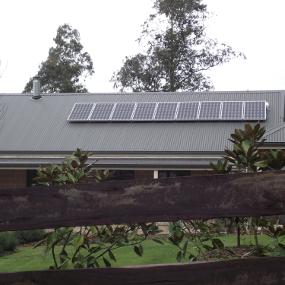Build it Back Greenbushfires
Solar Power
 Solar
photovoltaic systems are made from a series of panels cut primarily
from silicon that directly convert energy in the form of light from
the sun into electrical energy. Solar power can be used in all
parts of Australia as long as you have a suitable site with a
north-facing (or almost north facing) roof, or ground space that is
not shaded during the day.
Solar
photovoltaic systems are made from a series of panels cut primarily
from silicon that directly convert energy in the form of light from
the sun into electrical energy. Solar power can be used in all
parts of Australia as long as you have a suitable site with a
north-facing (or almost north facing) roof, or ground space that is
not shaded during the day.
With a grid-interactive system the energy produced by the solar panels is fed directly into the mains grid via a device called an inverter and through your electricity meter. The home can also draw power from the grid when the sun is not shining. This is the simplest system, and requires little or no maintenance, other than the occasional check to ensure it is still operating, and cleaning the solar panels of excessive dirt build-up.
How big a system you need and how much it costs is dependent on how much energy your house consumes. Probably the most important part of solar system design that is often overlooked is the energy efficiency of a home. There is no point spending money on a solar system when the energy it generates is wasted. Spending a few hundred or even a couple of thousand dollars on more efficient appliances and making your home more energy efficient means you can buy a smaller solar power system, and save significant amounts of money over the longer term.
A typical home system is between 1 and 3 kilowatts (1,000-3,000 watts) of peak generating capacity. A 1.5 kilowatt system costs around $10,000 before the subsidy that can be gained from creating and trading its Renewable Energy Certificates (RECs) (www.ata.org.au/rebates/federal-recs-renewable-electricity/) The wholesale price of solar panels has been highly volatile recently, with significant reductions over the past 12 months on the back of reductions in global silicon prices, variations in the value of the Australian dollar and manufacturing process improvements.
There are no direct government rebates for installing a solar power system. Instead they qualify for RECs created through the Renewable Energy Target market. The amount of RECs your system qualifies for is dependant on its size and your location. As an example, a 1.5 kW system in Melbourne is currently allowed to create and trade 133 RECs, and the current REC price is approximately $40.
In most states including Victoria, if you have a grid-connected system, you may also be eligible for a feed-in tariff and get paid for the clean, green power you put back into the mains grid. In Victoria there is a net-based feed-in tariff in which you are credited on your bills at least 60 cents per kilowatt-hour for solar electricity fed back into the grid, after household consumption. When installing a grid-connect system ask your electricity retailer what feed-in tariff they offer as some are more generous than others. Alternatively, you can check out the Victorian Retailer Feed-in Tariff Survey on the Alternative Technology Association website.
Warranties on the components of solar systems range from one to ten years for inverters; with the better quality panels offering 20 to 25 year guarantees.
As with all things, careful consideration of both price and quality should be undertaken to ensure your home's best option. Always get at least three suppliers to quote for the same size system so you are able to compare prices. Ask for details on the type and quality of solar panels and inverter. Also make sure that the installer has Clean Energy Council accreditation.
Suppliers
Energy Matters - www.energymatters.com.au
Ph. 1300 727 151
EnviroGroup - www.envirogroup.com.au
Ph. 03 9480 1905
Going Solar - www.goingsolar.com.au
Ph. 03 9348 1000
Ingenero - www.ingenero.com.au
Ph. 1800 993 334
K & C Solar - www.kcsolar.com.au
Ph. 03 5460 4224
Origin Energy - www.originenergy.com.au
Ph. 1300 791 468
NuEnergy - www.nuenergy.com.au
Ph. 1300 768 225
Solar Charge - www.solarcharge.com.au
Ph. 03 9596 1974
Yarra Energy - www.yarraenergy.com.au
Ph. 0413 795 926
Listed suppliers are a guide and are not endorsed by Green Cross Australia or the Alternative Technology Association.
Latest images
flickrLatest videos

Les' home is an inspiring example of smart green building, and his plans for living green will maximise energy savings and comfort. But it wasn't easy.

Peter Auty, Flowerdale resident, talks about the new Flowerdale Bus, 18 months after the Black Saturday bushfires.


